August/September 2011
M is for Monastery
And S is for Srbija
In some ways Serbia (Srbija in the local dialect) is a lot like Bosnia i Hercegovina;
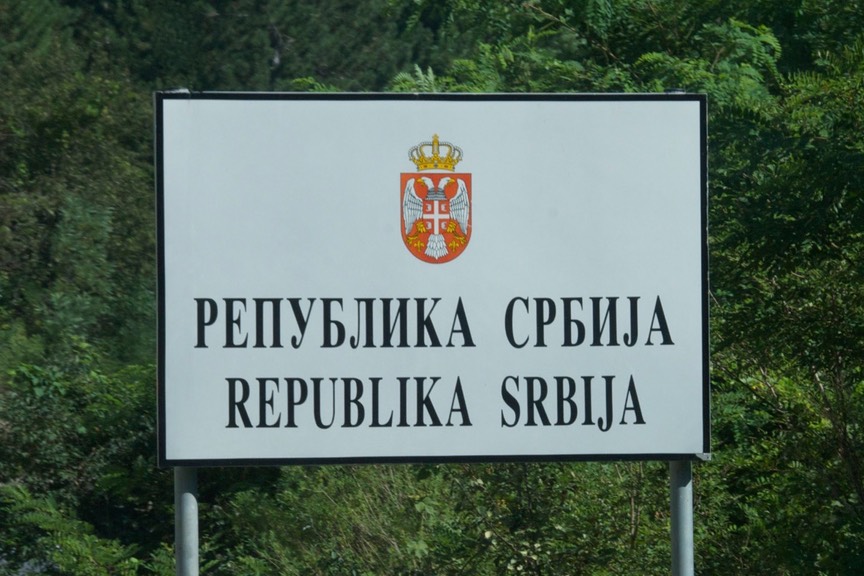
sheep and goats mixing it up with the cattle on the hillsides, all looking longingly at the haystacks accumulating food for them for the winter. Piles of wood beside every house. Rolling hills and mountains and hot weather at the lower elevations. At higher elevations we saw some very interesting and different Alpine-looking houses, but generally the housing looks very similar all over the Balkans.
One kind of architecture, however had become quite different: the orthodox churches were unique – and we liked the new style. How were they different? Well, boxier, I guess you could say, but only overall. There were lots more angles and curves and the interiors seemed much more intimate. There were frescoes everywhere on the older churches, often in excellent condition. No towers on top, just a dome. We found them very appealing.
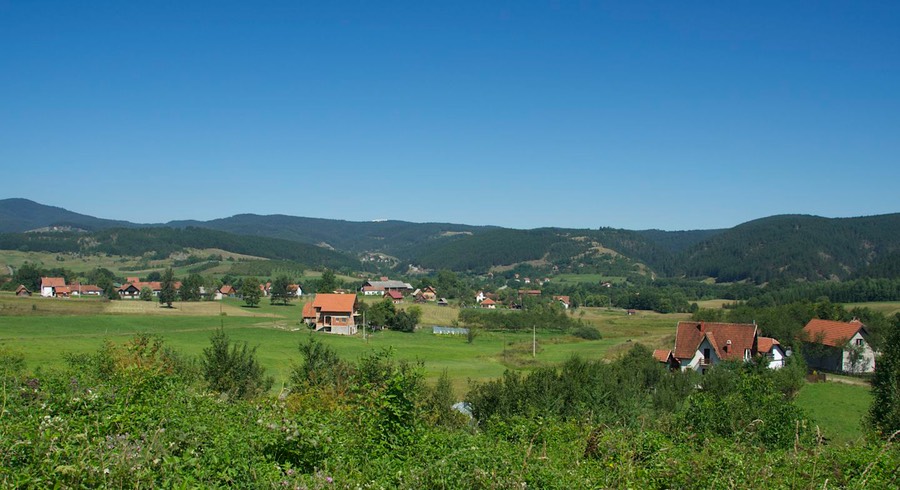
Our adventures have taken us to Serbia twice, first as we moved east toward northern Bulgaria, and then, post-Bulgaria, heading west back towards Bosnia; but neither time were we there longer than a week. It was one of those transition countries; but we chose good routes both ways, and saw what we feel is a good cross section of the country -- and some interesting sights.
Entering by crossing over the mountains and moving east, we quickly noticed that it was much drier east of the range. There was plenty of open, undeveloped land, like in the American west. We reminded ourselves that it was late August, and hot; cool and moist may not be part of these peoples’ lives at this time of the year.
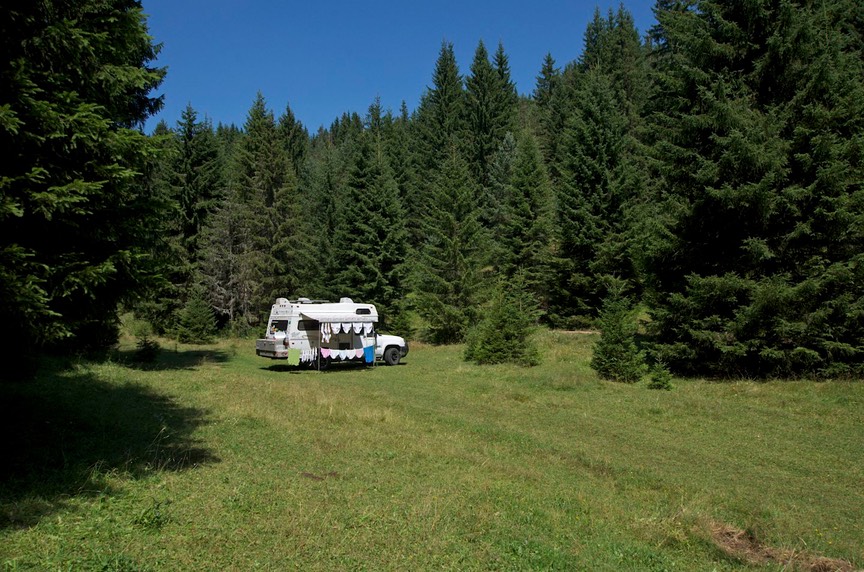
We entered Serbia pretty much in the middle of the western border with Bosnia. Our plan was to angle southeast to Novi Pazar, then loop back further north to the Beograd area, then pretty much due east into Bulgaria. In dropping south, we traveled through lots of forested areas, and soon found a lovely place to stop for a couple of days while we caught our breath and got organized to enjoy a new part of the Balkans. This has become something of a Balkan Tradition for us; crashing for a couple of days as soon as we enter a country. We simply cannot keep ahead of ourselves in terms of studying the guidebook for the new country while keeping reasonably caught up on our notes and photos from the previous country. Whew!
We had turned off the main highway onto a gravel road that took us back into a meadow; we were up almost 5000 feet, there were cows, it was quiet; idyllic. The cows visited us twice a day as they chewed their way across the meadow. We could hear them coming, and soon christened them the Bovine Bell Choir. We’ve never met a cowbell we didn’t like. Rick didn’t want to leave.
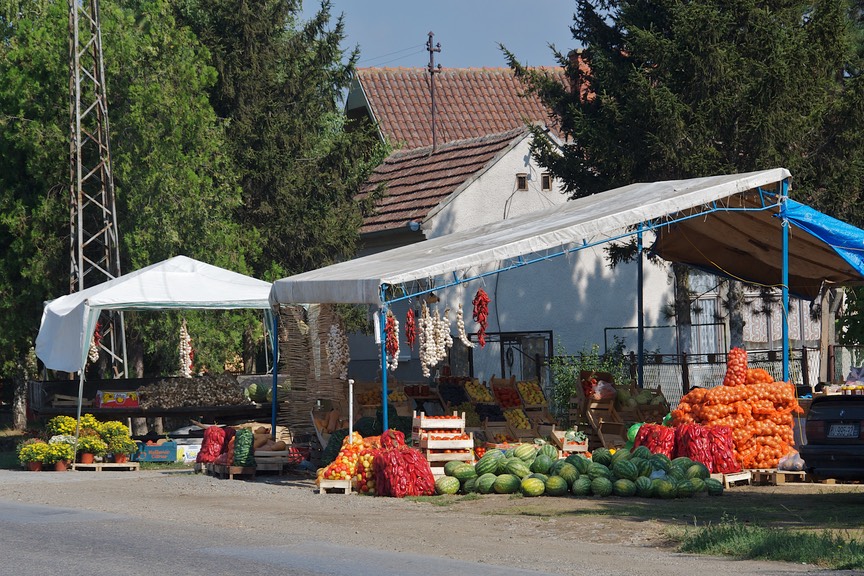
As we read materials, looked at maps, and caught up on computer work, we commented on what was new, and what was a continuation of the other Balkan countries we’d visited. You continued to be able to buy a shot of liquor at roadside stands. Fruit and vegetables were also plentiful at the stands: tomatoes and watermelons were dirt cheap but we’d said good-by to the peaches; less corn in the fields and we saw some bailed hay for the first time. Fresh spring water running from spigots where we could fill our water tank was still plentiful along the roadsides. The fields were tidy, but the towns seemed more chaotic and messier.
Generally, the roads seemed better than those we’d left in Bosnia, and the road system more modern, at least somewhat. Emily was certainly a lot happier and that makes us all happier. She’d found us again, and had returned to a normal level of detail in her mapping. We don’t know quite why Garmin hasn’t gotten around to Bosnia yet, but were relieved to see that it wasn’t going to be an ongoing problem – fingers crossed. By the way, go to Google Maps, it’s the same; we guess they must share the same sources but we don’t know.
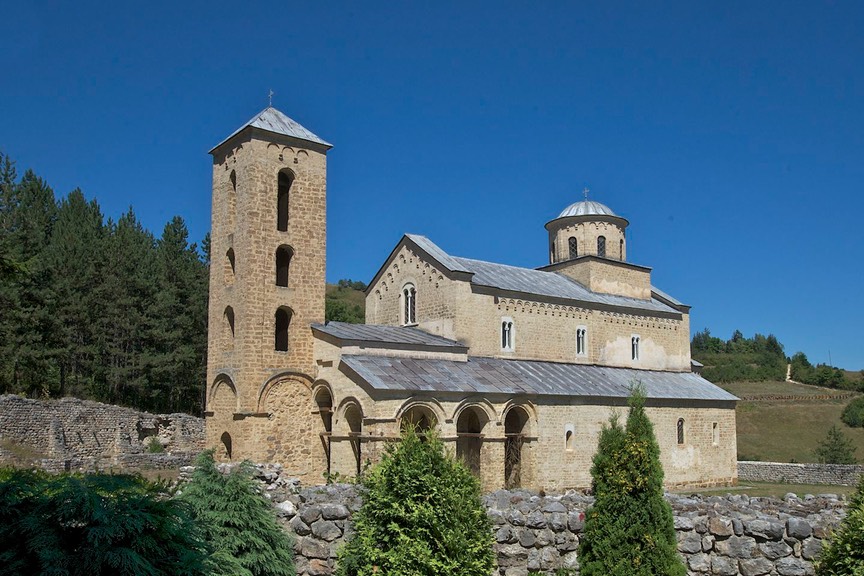
After a couple of days of catching up, on we trekked. Our first port of call was the Sopoćani Monastery, a lovely spot. We wandered at will, enjoying the early frescoes and taking tons of pictures. We were allowed much more freedom here than in the monasteries in other countries. We found it would vary from church to church, but most often we were allowed free access as long as we didn’t use our flash, which we almost never do anyway.
We headed way south, almost to the Kosovo border (which is disputed still), seeking Novi Pazar. It would be good for internet coverage, and it also interested us because of its strong Turkish presence. We didn’t have the chance to see much – it was way too hot, middle of the afternoon, and it seemed the whole town was torn up having the streets replaced. There is supposed to be an excellent Turkish market in town, and we would have enjoyed seeing it. We’ll be in Turkey this fall, however, and will have plenty of opportunities. We did spot a woman in a burka, our first since Paris.
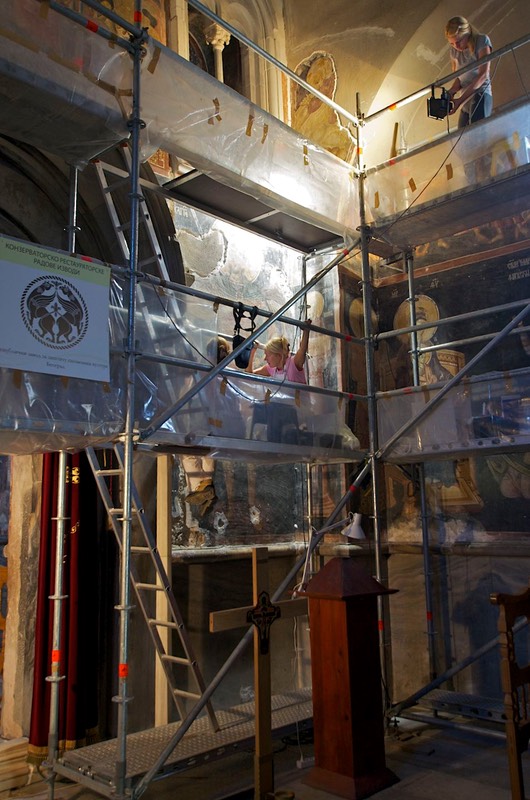
Late that afternoon, moving on, we stopped in the village of Nova Pavlica; we were seeking the church of St. Pavlića. We got lost, naturally, and stopped to ask directions of a teenage fellow walking through the town. He looked at us, then at the truck, and said “Where are you from?” We replied California, and he, quite amazed, said “What are you doing here?” Then he grinned and pointed us down the right road. We’ve had this happen often in the Balkans; it’s kind of, “If you can be in California, what the hell are you doing in this neck of the woods?” The church of St. Pavlića, while interesting and worth the quick stop, was not nearly as charming as our exchange with the local lad.
We were actually heading for the Studenica Monastery for the night. We stayed in their parking lot, and had a lovely and quiet evening of it. The next morning we visited the complex, and it was an outstanding experience, our best so far in this country. There is a large on-going restoration program underway, and it was really interesting watching the work. And…the place was incredible. The artwork was amazing; I’m in love with Serbian orthodox frescoes.
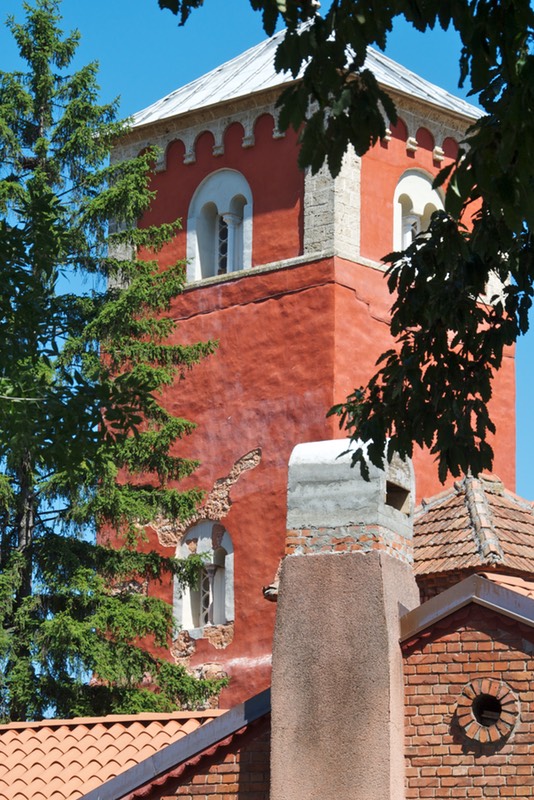
Serbia is chock full of monasteries. (Somehow the recent wars either missed them or they’ve been repaired.) Our map has bunches of them marked out for us and roadside signage is pretty good. Not wanting to miss anything important, we stopped to check out the Žiča monastery on our way north toward the Beograd area. This monastery surprised us by having many Moorish elements, with lots of the design work around the windows that we had become accustomed to in Morocco. Also, it was an outstanding rusty red color. So the exterior was very intriguing. The inside was not such a big deal, but we were happy to have given it a bit of our time.
South of Beograd we arrived at Topola, which we’d really been looking forward to. It did not disappoint. This would turn out to be one of the best visits we made in Serbia. Topola is a very nice small city of about 25,000 comfortable folks maybe 65 kms south of the capital. The town is on a hillside, with vineyards, views, and an excellent infrastructure. The countryside all around is lovely rolling farmland. We were able to find a café with internet, made friends with the lovely - down Rick - barmaid, and hung out for a couple of hours. We slept the night just on the edge of the town cemetery.
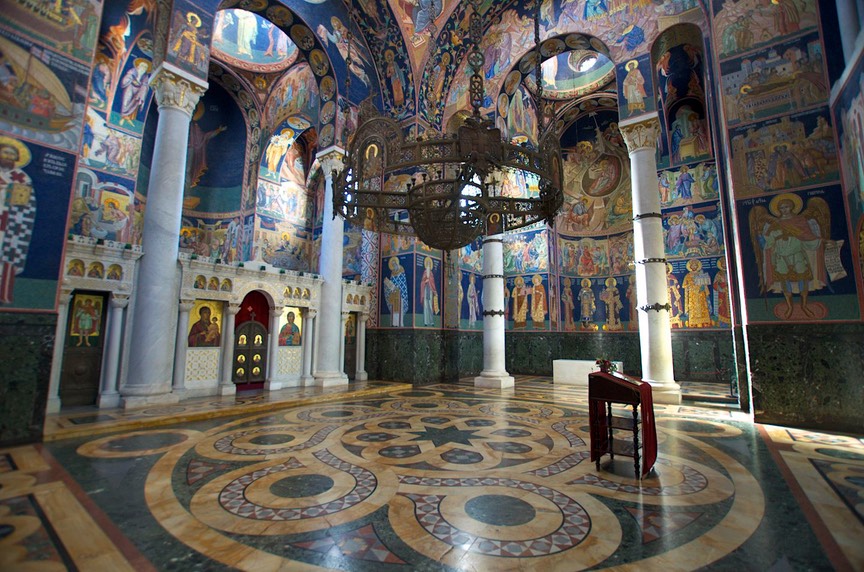
But all that wasn’t why we’d come. At the top of the hill is a wooded park area and the church of St. George. Built by King Petar I (and finished in 1912) it is the family mausoleum; Petar I was the grandson of the guy who, in 1804, led the Serbian insurrection against the Turks. Anyway, the church is stunningly decorated with, we were told, sixty million mosaic tiles in fifteen thousand colors, and it is astounding. It proved rather difficult to photograph for a variety of reasons, but a lack of color certainly wasn’t one of them. Nearby is Petar’s former home; it is now a museum filled with displays about him. He was quite a guy; during World War I he, as an old man, was out there encouraging the troops. There are also photos in the museum from 1912 showing the king with a group of Serbian airplane pilots. You will remember that it was a Bosnian Serb who killed that ole archduke, “igniting” World War I. The Serbs have quite a history.
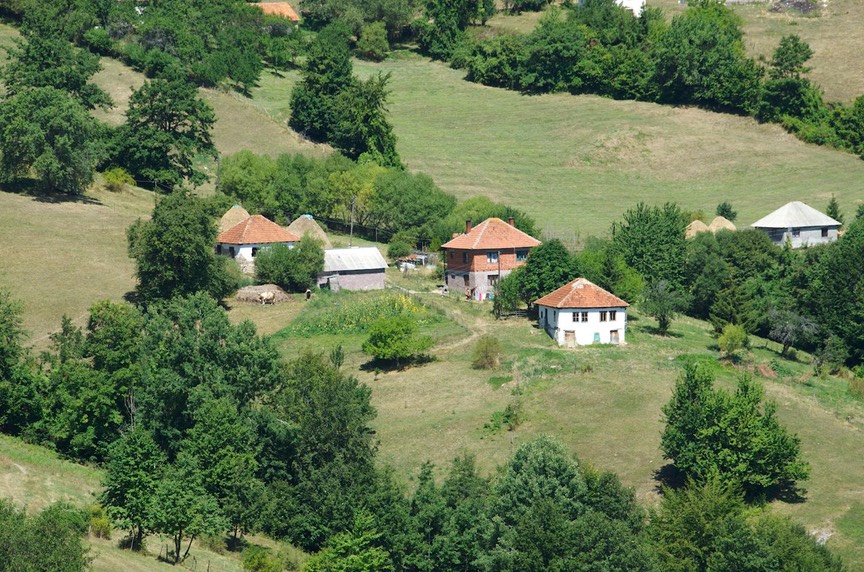
East of Topola it looked like the California valley: hot and dry, small farm towns with houses that were simple but adequate and lots of shade trees in the yards. Most of the yards were fenced, but the fencing was more elaborate than we’d seen before – fancy wrought iron or decorated wood or concrete.
In this central part of Serbia the towns seemed cleaner and less scruffy than we’d seen further south; there were recycling bins around, and the trash was under better control. We were seeing lots of new cars (red still the predominant color by far), but oodles of old stuff, mostly old Soviet-era brands like Yugo, Zastava, and Lada. Boy are they ugly! We also continued to see lots of really old small tractors of the same brands; Rick thought they were all a lot of fun.
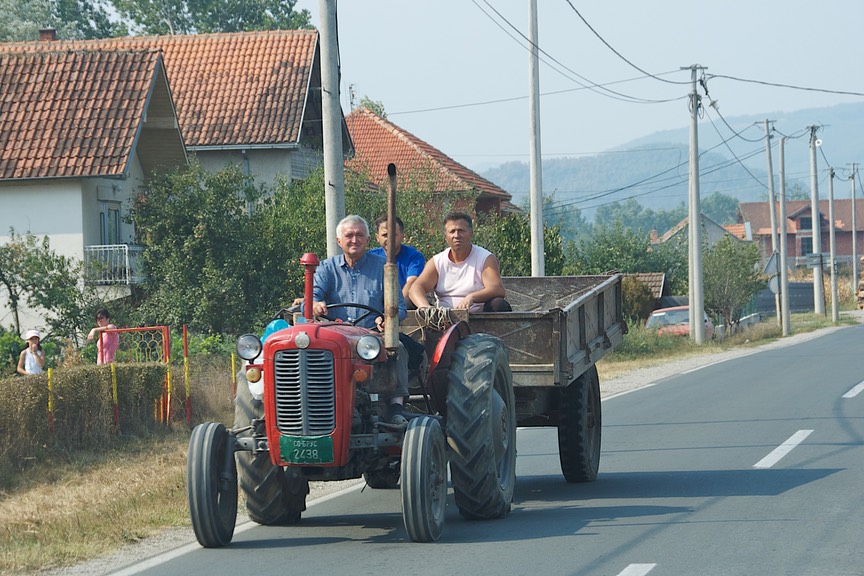
One great thing about these countries: regardless of how hot it is, there is still plenty of water in the rivers, and in the countryside you can get fresh, clear, sweet water from the springs alongside the roads. Regularly we fill our tanks from them, and think about those countries we’ve visited over the years where this would have been impossible.
We made one last monastery visit before entering Bulgaria, stopping at the Manasija monastery outside Despotovac. Under restoration, it still was quite interesting to see; its claim to fame is its heavy fortifications, including a huge wall complete with a total of 11 towers. It was much simpler than many we’d visited, but quite worthwhile. Sadly, no pictures inside, and the outside wasn’t much.
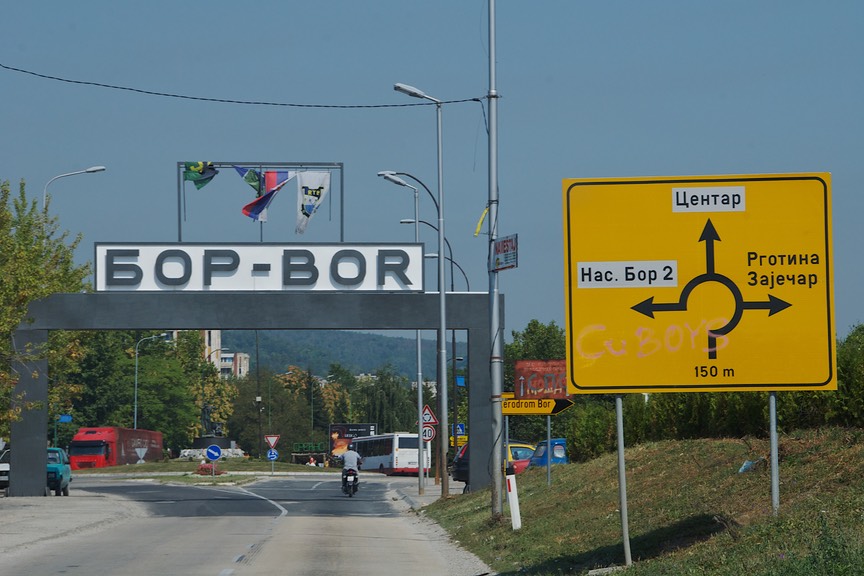
Then we started off southeast to pick up the road to the border. And immediately knew we were in never-never land. The road we wanted was on our map; it was also very clearly marked on the GPS. We reached the turn off for it: no road – no sign it had ever existed. We were next to an army encampment; perhaps they had obliterated it? So we went a zillion miles out of our way, circling around to get to the main road by other means, and then later on passed the point where “our” road was supposed to join in. No sign of it. The Incredible Missing Link. Damn!
Trucking on, next we encountered another long detour – this one for road repairs. Looking at the map, if we’d only taken a different road when we left Despotovac, we’d been way ahead of the game. Ain’t it just always the case! Our detour took us through the mining town of Bor (which is spelled Bop in Serbian/Cyrillic – it will always be Bor-Bop to us).
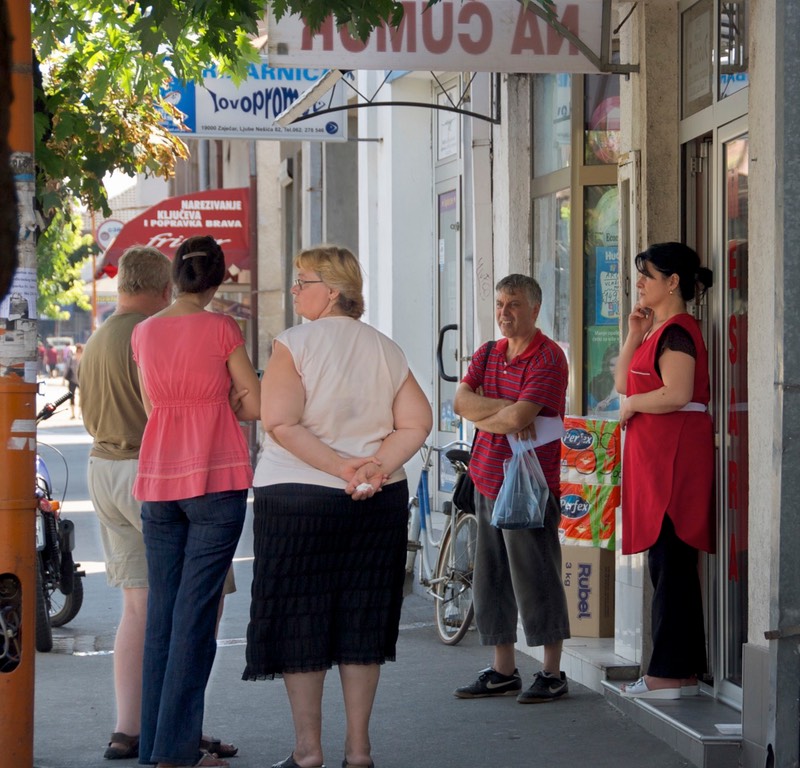
But eventually we were approaching the border; we stopped in Zaječar before crossing in order to pick up internet, not knowing what we might be facing on the other side. And that led to another adventure. In these cases, with no known quantity like a McDonalds around, we’ll typically get out one of the computers and troll around looking for a wifi signal; then we’ll go into the hotel or café that has the signal and arrange to utilize the connection. If trolling doesn’t turn anything up, we’ll get out and try asking for help in an area that has some cafes. Well that’s what we did here and it was a hoot. Rick was the designated asker, so here he is, this big ole ‘murican, standing in the middle of the sidewalk with the laptop in his arms and three or four folks around him trying their best to help; not a word of English among them.
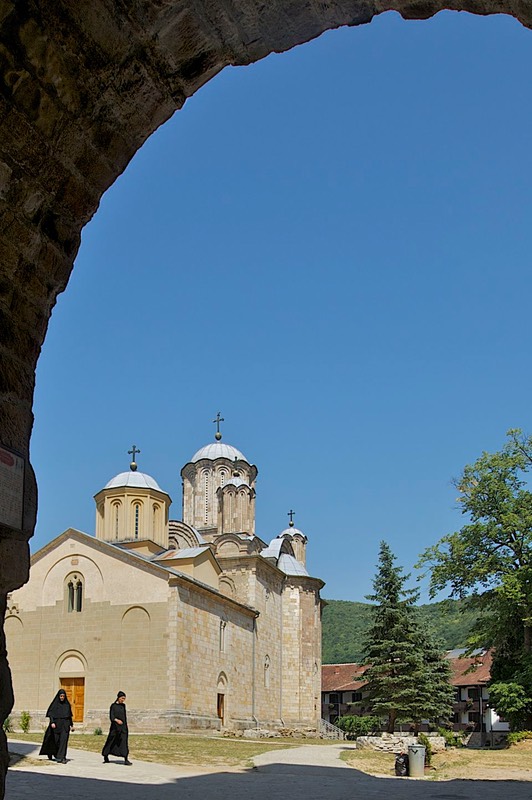
He had actually came up with a connection standing right there when an educated voice behind him asked, in excellent English, if he needed any help. This was Danko Nikolic, Program Director at the Zajecar Initiative, a youth program located just around the corner. Nothing would do except for Rick to follow him up three flights of stairs to his office where the wifi was excellent. This turned out to be especially helpful when one of our incoming messages asked us to fax or email a document to them. Rick was able to go back up to the office, where they gladly scanned the item and Rick sent it on, saving us a whole other hassle of finding someplace where we could do this.
Finishing Rick’s Excellent Adventure, we headed for the gendarmes and customs officials at the border crossing. It was pretty simple and straightforward. No one stamped us out, but we did get stamped into Bulgaria – and suddenly we were back in the European Union. On both sides someone checked out the interior of the truck; we’ve decided it’s because they’re curious, not actually looking for anything. Bulgaria required us to buy a vignette for the use of their roads, and then we were on our way with another cool sticker (the vignette) on the windshield.
We spent most of a month in Bulgaria, with all the usual adventures – both positive and negative. We’ll be traveling back across the south portion of that country in about a month, and we’ve decided to hold off on revealing the details until then. So you’ll just have to hold your breaths.
* * * * *
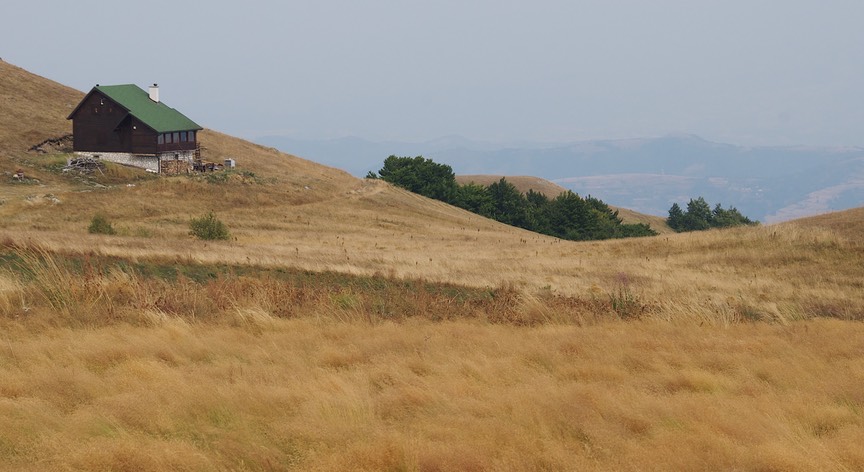
It’s now most of the way through September and, after nearly four weeks in Bulgaria, we have finally turned west again. We’ve re-entered Serbia, with Kopaonik National Park, high in the mountains, as our first destination. We had heard that this was a lovely, natural area, and we were delighted to be there. There is skiing in the area, and the National Ski and Snowboard Camp, but otherwise it’s been pretty much left alone. It was still dreadfully hot at lower elevations (95 degrees during the day), but cooled quickly as we climbed. It was also getting dark and stormy looking. We arrived on an isolated ridgeline late in the day, and we settled in, enjoying the views on all sides. The wind picked up – a lot. It began to storm; we felt very exposed and decided to move a bit further along, looking for a more sheltered spot. Glad we did. We settled along the edge of a resort area, protected a bit. The storm kept up all night, and most of the next day. It was quite something. But the cool deal? The weather had broken! It got down to 49 degrees that night and we slept with an extra blanket for the first time in months! Awesome!
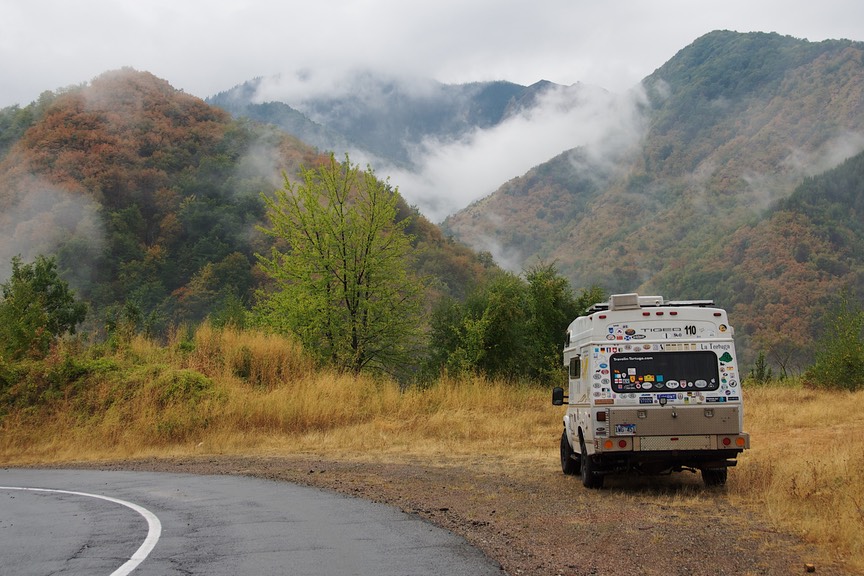
It has stayed cool ever since. With that storm, autumn seems to have arrived. The quality of the sunlight has changed. There are still apples on the trees, and the roadside stands still have some fruit (including diminishing mounds of watermelon), but it’s definitely the end of the season, and bargain prices prevail. Now we are seeing cabbages and root crops and peppers – all kinds of peppers, reds and yellows and green ones for pickling. Unfortunately, Rick doesn’t do peppers; or pickling.
We are seeing more and more fall color, and what was very dry and dusty a few days ago is now fresh and pretty after the rains. Oh, yes, and kids; tons of kids; school is suddenly in session.
Dropping down in elevation, we continued to stay in the foothills as we worked north along the western edge of the country. Our plan included a brief visit in Beograd, the capital, to catch some wifi and deal with some paperwork issues, and then to head to Novi Sad, not far away. Beograd was pretty ugly and a mess, as we’d read, but it had good internet services for us. So we fought our way into the city, and took care of business with the help of a nice young lady who spoke some English.
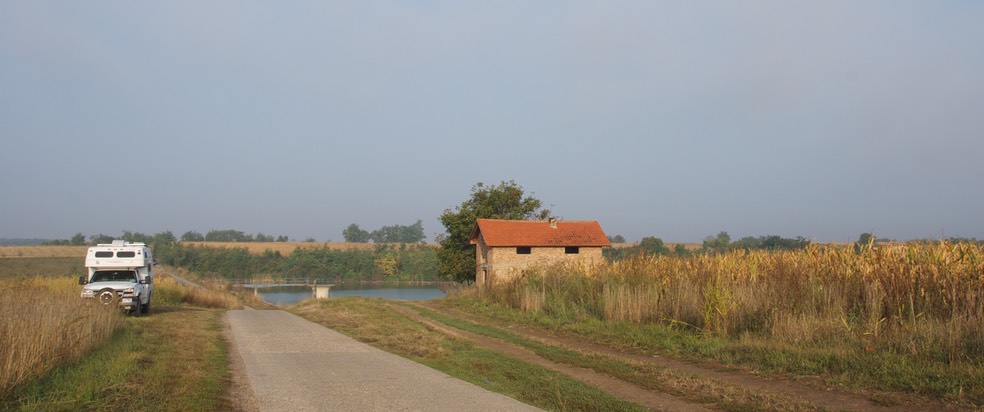
We are realizing that none of these large cities in the Balkans have the infrastructure in place to handle the influx of cars they’ve seen in the last 20 years. Every intersection is fraught – and we can’t say much for the Serbian drivers. They’re pretty aggressive, and that’s for starters! We can’t wait to get to Turkey, where the drivers are supposed to be really, really bad. Rick just shrugs; after Latin America it will take a lot to get his attention when discussing bad drivers; we’ll see. One of his favorite compliments ever was some years ago in Mexico when another gringo told him he drove like a local; ‘When in Rome’ is his motto.
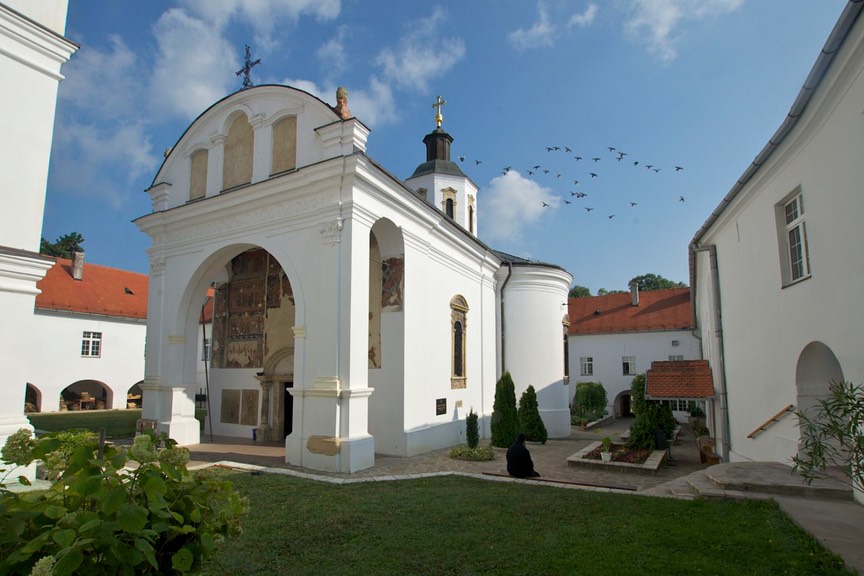
Getting out of town, we headed out into the very lovely countryside and made our way north towards Novi Sad. We spent a quiet night out in the farmland, parked near a fishing pond and next to a cornfield – the corn has all been picked, but most of the fields have the stalks drying in place and it’s a beautiful color. There were lots of blue and yellow flowers at the edges of the fields. We saw our first pheasants. The farmers have started clearing some of the fields, and there’s a lot of dust in the air. Even after all that heavy rain, the sun is bright red when it comes over the horizon in the mornings and returns at night.
Puttering along, we entered an area of rolling hills and forests that’s called Fruška Gora. It’s famous for its vineyards and monasteries. It’s truly special; we stopped and visited the Krušedol Monastery, where we outlasted 5 tour busses filled with a combination of school kids and German tourists off a Danube River cruise ship. After they all left we had the exquisite buildings all to ourselves. The Serbian monasteries are often in lovely rural areas; the grounds and setting are just as delightful as the buildings and their contents. We had a lovely time.
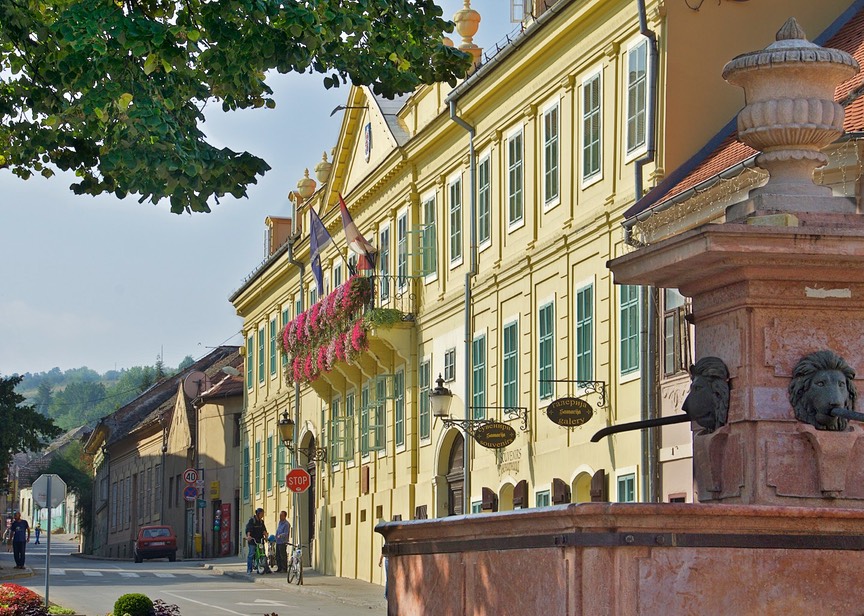
Then, approaching the city of Novi Sad, we had another one of our special experiences. We stopped in the town of Sremski Karlovci. It’s charming, Baroque, Austro-Hungarian (we’re pretty close to Hungary by now), and we loved its feel and look. If you come to Serbia you must check it out. The town was setting up for a huge wine and local foods event, but we managed to see it before all the apparatus was in place; not to mention while we could still find a parking spot.
The town was the seat of the Serbian Orthodox church and has a swell cathedral. But even more interesting, this was the site of the first Serbian grammar school in the country (grammar = high school). A couple of hundred years back, all the schools were run by the Austrians and the instruction was in German. Well, the local burghers found a way (it’s called money) to convince the king or prince or whoever to let them start up a school that would be taught in Serbian and would teach Serbian history and culture, and so they did. About 1900 a really classic building was constructed for the school, right off the square. We wandered in and out of it, enjoying the architecture but even more enjoying the excitement and energy of all the kids wandering around inside and outside and up and down the streets. There was a dynamism to the area that we thoroughly enjoyed. We spent some time talking to an English teacher; she was so excited about what her students were doing (reading Hamlet in English) that we got all jazzed right along with her. It was great.
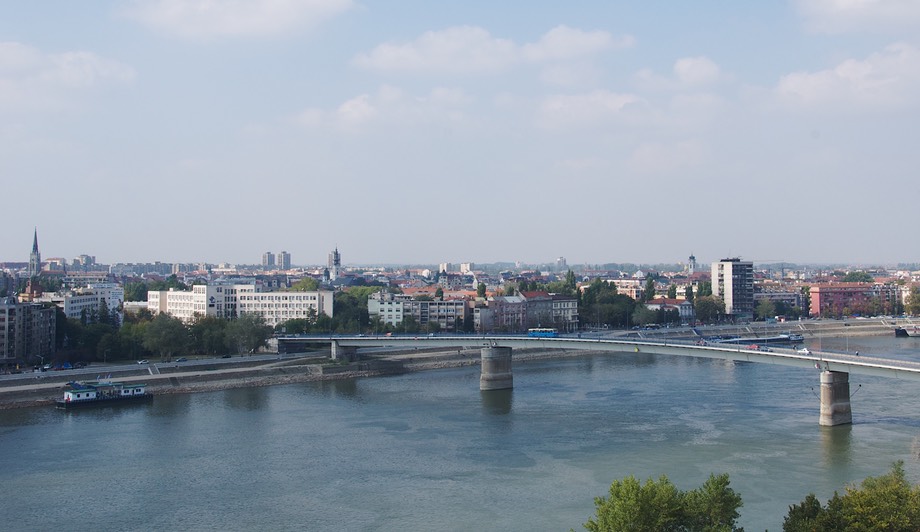
Next we moved on to Novi Sad, which is a large city on a bend in the Danube River. It has a large citadel, right across the river, designed by the Frenchman Vauban. We like large citadels on bends in rivers, particularly ones designed by Vauban. Totally cool. We found our way there and happily wandered, looking at the city across the way, the river traffic, lovers sitting at the end of one of the star points (an important defensive design element), and the medieval village at the foot of the fortress. Happy campers we.
We crossed into the city; it has a lovely old center, now pedestrianized, with cafes and art galleries and fun shops and a lovely park to enjoy. And a terrific historic museum, which we also happily puttered through for a couple of hours. It’s a happening town, hosting the enormous Exit Festival each summer (at the fortress) that attracts about 200,000 happy folks. Quieter in the fall, but still plenty going on. We enjoyed being there a lot, and were very glad we’d made the detour to get that far north.
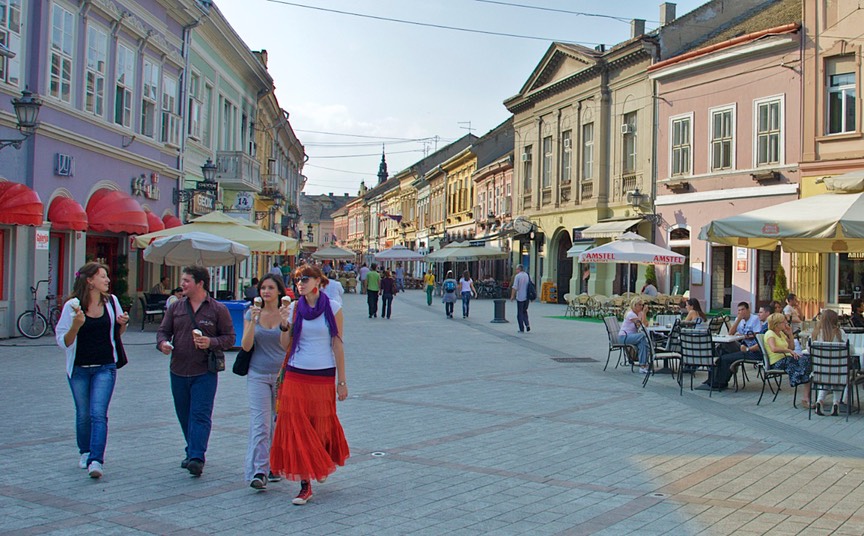
Our first and biggest challenge in arriving at any medium to large city is to solve the riddle of “Where can we Park?” Here in Novi Sad, after wending our way through the requisite number of traffic jams, one way streets and “don’t everybody breathe at once” narrow places, we came upon a market area that actually had a large parking area attached; problem solved thought we. Welllll, almost. We had to figure out how to pay, and therein, as they say, lay the rub. We found the machine, emblazoned with Cyrillic lettering of course, but could not figure out how much to put in; not to mention that we had only a few local coins to our name. Not finding anyone to help, we trudged on over to the museum a block or so away to ask for some assistance. Well, the lovely lady could absolutely not have been nicer. First she said, in very nice English, that she’d just call in on her cell phone and take care of it, presumably with some charge to her account. Welllll, almost. After several minutes of trying, she showed us the screen on her phone where it clearly said “System Down” or words to that effect, shrugged and said, “Serbia”. Next, she grabbed some change and walked us out to the machine on the street in front of the museum, inserted copious numbers of coins and produced a ticket good for one hour. Cool! So, we started in to enjoy the museum, but of course we needed more than the one hour, so Rick trudged back to the coach at the appointed time in hopes of getting another ticket.
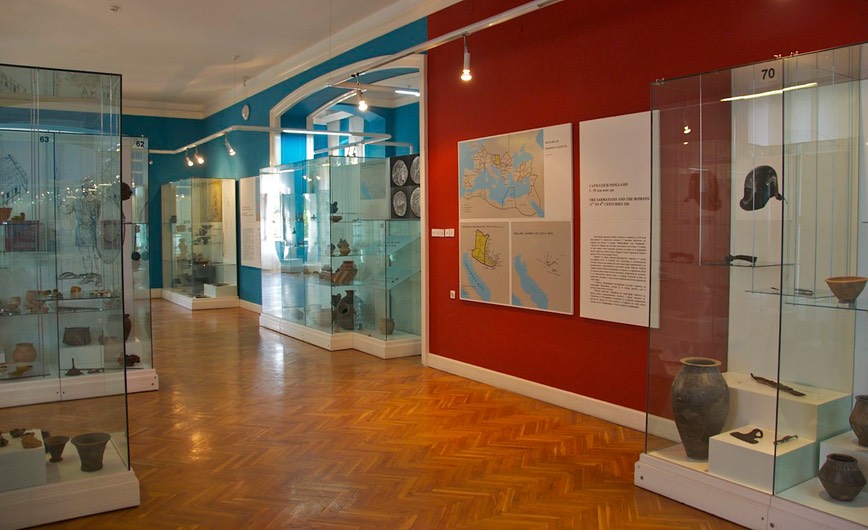
Whew, still with us here? Now we begin our second positive encounter of the afternoon: Chapter Two of the ‘Case of the Serbian Parking Meter’ and our third instance of Welllll, almost. Armed with a fistful of coins provided by the nice museum lady, and having watched carefully when she managed to coax a ticket out of the machine, he began. Well the machine was full or something; it liked some of the coins, but many just passed through like *%@# through a goose and no ticket was forthcoming. Looking up in despair and frustration, he saw the uniformed parking meter person approaching the truck and hurried over. He attempted to explain the difficulty; blah, blah, coins, blah, blah, bleeping machine, etc., etc. because of course, the lady spoke no English. Well, apparently the inability of the machine to produce a ticket came as no surprise; that’s why everyone uses the cell phone system, silly. But sensing that this wasn’t going to work, she pointed and said “Kiosk”, seeming to indicate that one could purchase a ticket from an actual person in the event of… well, you know. AHA! Wellll, almost. There was no one at the kiosk. Returning to the meter maid, Rick was delivered at last when she shrugged, said “Serbia” and waved him away with a smile; she knew the truck, she knew that Rick had tried to do the right thing, and she certainly understood that sometimes things just don’t work the way they should, in -- “Serbia”.
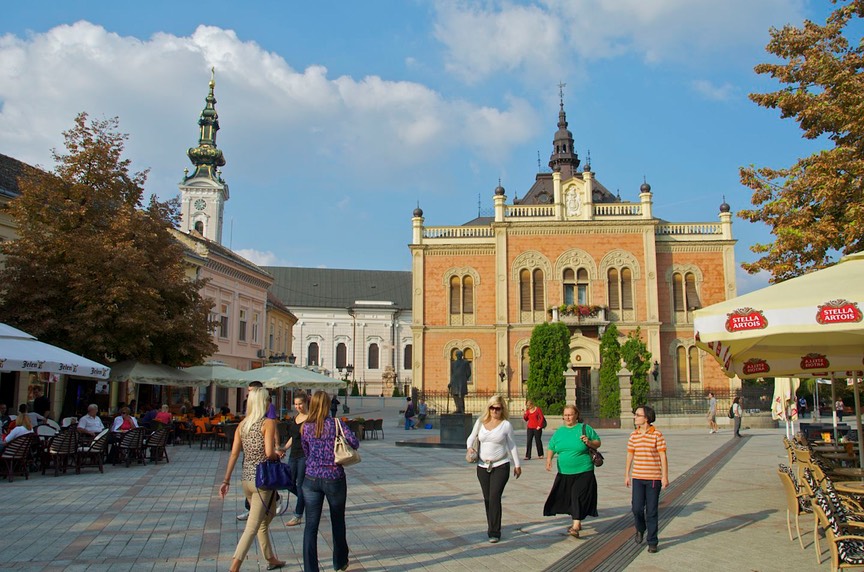
Late in the afternoon, totally whooped, we left town and trucked a little further southwest, aiming for the Bosnian border. We had one last stop in mind, and it turned out to be an incredible jewel. We arrived at a grassy bluff overlooking the Novo Hopovo monastery just before the sun set, and settled in for a very quiet night in a bucolic, rural spot in the woods outside a small village. Both in the evening and then again in the morning the sound of the bells surrounded us.
Early the next morning (well, early for us) we visited the monastery and found ourselves overwhelmed. The church within goes back to 1576, and although badly damaged during various wars, it has been repaired after each of them and is delightful to see. The grounds inside the monastery walls are peaceful and filled with flowers. The living quarters are modern, but somehow fit in with the 16th century church structure. We had the grounds and interiors to ourselves, and spent a long time enjoying the experience.
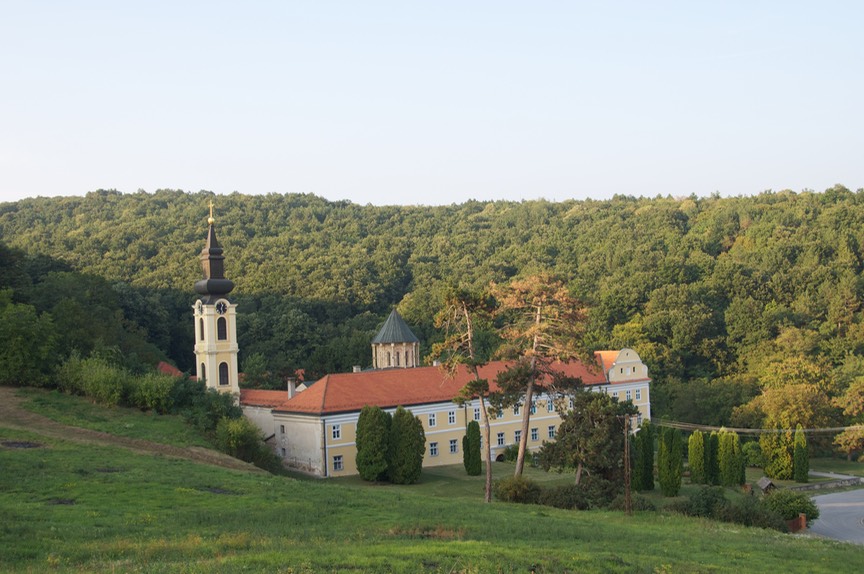
Leaving the area, we followed the Drina River south to our chosen border crossing, at Zvornik. The road was awful, there was too much traffic, etc. etc. But we talked about the last couple of days and how we’d enjoyed this corner of Serbia very much. The rolling countryside and forested hills, two great towns to visit; and a clutch of charming Orthodox churches. We’d gone out of our way to get up here, and were pleased with the experiences we’d had.
Serbia itself is well worth the effort. In general we enjoyed the northern areas more than further south. They are not only a bit cleaner and more developed, but as in Croatia, the northern areas reflect the presence of the Austrians who controlled the area for so long. The European styles of the buildings along with wide boulevards and plazas make the old downtowns prettier and more interesting, and overall the landscape is a little greener and more inviting. But there were very nice areas everywhere, more mountains than we’d expected, and lovely valleys with wandering streams.
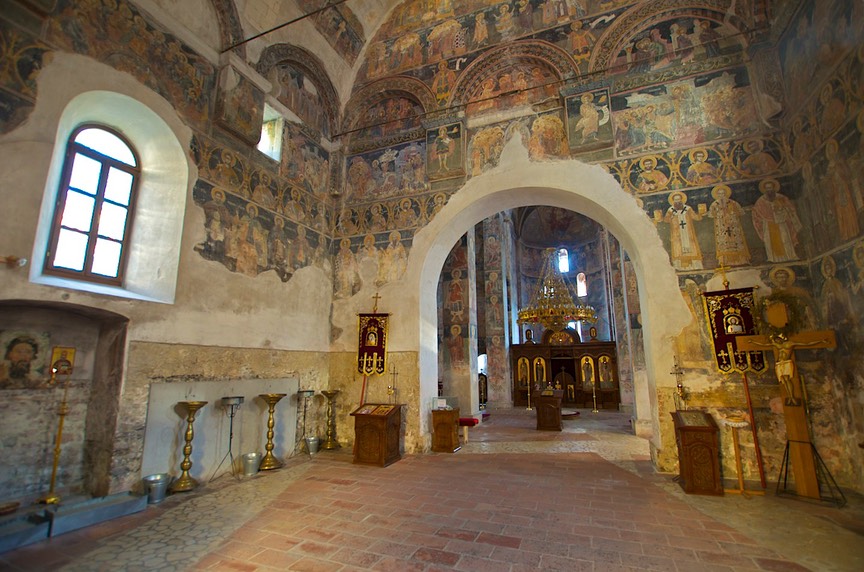
The people, as always, were charming and helpful. Every country we’ve ever visited has welcomed us, but here in Serbia we’ve received some of the most positive responses yet, both to our presence in the country and to our mode of transportation. Folks were friendly and welcoming and we certainly saw the most “thumbs up” gestures of the entire summer, accompanied by lots of smiles along the roadsides.
But without a doubt, the best thing about Serbia has to be the monasteries and churches, both new and old. We wish we could have seen them all, but there are sixteen monasteries just in the area near Novi Sad, so that really wasn’t a realistic goal. Fall is definitely here at last, and we have many miles to go before we reach Turkey and Greece. So, back through Bosnia to western Croatia and that stunning coastline we’ve been hearing so much about. More soon.
Love to all, Rick and Kathy and “Thumbs Up” Tortuga
Click to see more photos from Serbia